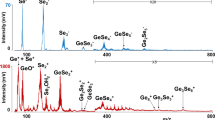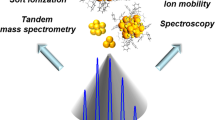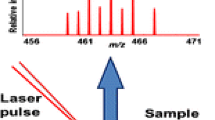Abstract
This study compared Sb2Se3 material in the form of commercial polycrystalline bulk, sputtered thin film, and homemade polycrystalline material using laser desorption ionization (LDI) time of flight mass spectrometry with quadrupole ion trap mass spectrometry. It also analyzed the stoichiometry of the SbmSen clusters formed. The results showed that homemade Sb2Se3 bulk was more stable compared to thin film; its mass spectra showed the expected cluster formation. The use of materials for surface-assisted LDI (SALDI), i.e., graphene, graphene oxide, and C60, significantly increased the mass spectra intensity. In total, 19 SbmSen clusters were observed. Six novel, high-mass clusters—Sb4Se4+, Sb5Se3-6+, and Sb7Se4+—were observed for the first time when using paraffin as a protective agent.

Similar content being viewed by others
Introduction
Sb2Se3 is known in nature as the mineral antimonselite. The crystal and electronic structure of antimony selenide as well as its vibrational properties were previously determined [1,2,3,4]. Generally, the SbmSen system is an important member of chalcogenide materials. Under typical experimental conditions of chalcogenide glass synthesis, the glass-forming region in the SbmSen system is limited to rather low antimony content (up to 30%) and smaller glass batches often face phase separation problems [5,6,7]. On the other hand, it is possible to fabricate amorphous, stoichiometric, and thin Sb2Se3 films by physical vapor deposition techniques such as radiofrequency magnetron sputtering [8] or thermal evaporation [9]. Moreover, Sb2Se3 forms stable glasses and amorphous thin films with other glass-forming selenides like GeSe2 [10,11,12,13]. Today, SbmSen materials, especially in the form of thin films, have been widely studied as for memory switching application [14, 15], as glass-ceramic or antimony selenide thin films for solar cells [16,17,18,19,20], as Sb2Se3 anode for lithium, and sodium batteries [21, 22].
In a previous article [23], we examined the formation of clusters produced by laser ablation from mixtures of Sb and Se elements in different ratios. We observed 24 SbmSen clusters that were generated from metal surface of common target. In this study, we would like to compare the stoichiometry of clusters formed by laser desorption ionization (LDI) from Sb2Se3 materials in the form of commercial polycrystalline bulk, thin film, and homemade polycrystalline material to the clusters generated by laser ablation synthesis (LAS) from the mixtures of elements (antimony and selenium). Additionally, in order to evaluate the influence of various surfaces on cluster formation, some other materials that act as surface-assisted LDI (SALDI) matrices (graphene [G], graphene oxide [GO], and fullerene [C60]) were used. Since paraffin (as a protective agent) was found to increase the intensity of chalcogenide high mass clusters [24], we also studied the assistance of paraffin in detail.
Experimental
Chemicals
Polycrystalline Sb2Se3 was purchased from Sigma-Aldrich (St. Louis, MO, USA). Homemade polycrystalline Sb2Se3 was synthesized using high-purity elements (Sb and Se of 99.999% purity). Acetonitrile, G, GO, and C60 were purchased from Sigma-Aldrich (Steinheim, Germany). Parafilm was purchased from Bemis NA (Neenah, Wis., USA). Red phosphorus was obtained from Riedel de Haën (Hannover, Germany) and was purified via sublimation in a nitrogen atmosphere. Water was double distilled using a quartz apparatus from Heraeus Quarzschmelze (Hanau, Germany). All other reagents were of analytical-grade purity. Amorphous Sb2Se3 thin films were fabricated by radio-frequency magnetron sputtering using an MPE600S (Plassys-Bestek, France) multichamber physical vapor deposition system. For the depositions, single crystalline silicon <100> substrates and a polycrystalline Sb2Se3 sputtering target (99.999%, ALB Materials, USA) were employed. The experimental details of thin film deposition are provided elsewhere [8]. No Bragg peaks were detected in the X-ray diffraction patterns of deposited thin films, which confirms their amorphous state.
Mass Spectrometry
AXIMA Resonance and AXIMA CFR mass spectrometers, both from Kratos Analytical Ltd. (Manchester, UK), coupled with a quadrupole ion trap and time-of-flight detection, were used to record mass spectra in both positive and negative ion modes. Both instruments were equipped with a nitrogen laser (337 nm), and the laser repetition rate was set to 5 Hz with a pulse time width of 3 ns.
Software and Computation
Launchpad software (Kompact version 2.9.3, 2011) from Kratos Analytical Ltd. (Manchester, UK) was used to determine SbmSen cluster stoichiometry via comparison of isotopic envelopes.
Sample Preparation for Mass Spectrometry
-
1.
Commercial Sb2Se3 polycrystalline bulk, homemade polycrystalline material and amorphous Sb2Se3 thin film
An agate mortar was used to pulverize the polycrystalline Sb2Se3; the powder was then suspended in acetonitrile (1 mg/ml). From the prepared suspensions, 10 μL was deposited on a MALDI target and dried in open air. The amorphous Sb2Se3 thin film was fixed on the target with a narrow piece of parafilm.
-
2.
SALDI using GO, G and C60 surfaces
Ten microliters of GO, G, or C60 suspensions in acetonitrile was separately deposited on individual spots of a MALDI target and then 10 μL of the commercial polycrystalline bulk Sb2Se3 powder suspension (described above) was separately added on the surface of the GO, G, or C60 suspension.
-
3.
Sb2Se3 covered with paraffin
Ten microliters of the Sb2Se3 powder suspension (described above) was deposited on a target and then covered with paraffin solution in xylene (1 cm2 of parafilm dissolved in 1 ml xylene).
Results and Discussion
LDI of different materials was used to generate clusters while mass spectra were recorded in both positive and negative ionization modes by using a reflectron mass analyzer. This analysis revealed that a low number of clusters and low-intensity spectra were produced in the negative ion mode. Therefore, the results obtained in the positive ion mode are presented.
Effect of Laser Energy on Homemade Sb2Se3 Polycrystalline Material Mass Spectra
The effect of laser energy on intensity of clusters formed is shown in Figure 1. The high-intensity clusters were observed in the 300–450 m/z range; the intensities heightened as the laser energy increased. However, some low-intensity clusters were also observed in the 450–650 mass range (spectra not shown). This data indicates that the homemade Sb2Se3 polycrystalline material was rather easy to decompose even at relatively low laser energy (140 a.u.). Detailed analysis of the homemade Sb2Se3 polycrystalline material spectra is shown in Figure S1A. In addition to SbSe2+, Sb2Sen+ (n = 1, 2) and Sb3Sen+ (n = 1–3) clusters, Sbm+ (m = 2–4) species were also detected. Comparison of experimental and theoretical isotopic patterns concerning Sb3Se+ is provided in Figure S1B. Overall, they showed good agreement.
Effect of Laser Energy on Thin Film Mass Spectra
The effect of laser energy on thin film mass spectra (Figure S2A) was different from that of homemade Sb2Se3 polycrystalline material. At 140 a.u. laser energy, the cluster intensities reached their maxima. The mass spectra showed that the thin film was less stable against pulsed laser irradiation than the homemade Sb2Se3 polycrystalline material the thin films were easier to ablate. An example of a thin film mass spectrum is shown in Figure 2. The thin film mass spectra showed similar clusters to those formed from the homemade Sb2Se3 polycrystalline material. However, the Sb3Se3+, SbSe2+, Sbm+ (m = 2–4), Sb2Sen+ (n = 1, 2) and Sb3Sen+ (n = 1, 2) clusters were not observed. There was good agreement between the theoretical and experimental isotopic patterns as exemplified for Sb2Se+cluster (Figure S2B).
Effect of Laser Energy on Commercial Sb2Se3 Polycrystalline Material Mass Spectra
Comparison of mass spectra generated from commercial Sb2Se3 polycrystalline bulk at different laser energies is shown in Figure 3. Even at low laser energy (120 a.u.), we observed several low-intensity clusters in the m/z range over 450. Figure S3A shows the result of detailed mass spectra analysis concerning commercial Sb2Se3 polycrystalline bulk material. Besides SbSe2+, Sb2Sen+ (n = 1–4) and Sb3Sen+ (n = 1–5), Sbm+ (m = 3, 4) clusters were also noted. Comparison of experimental and theoretical isotopic patterns for the Sb2Se2+ cluster is provided in Figure S3B; there was good agreement between the experiment with the theoretical model.
Comparison of Amorphous Sb2Se3 Thin Film, Commercial and Homemade Polycrystalline Sb2Se3 Material Mass Spectra
Figure 4 shows thin film, commercial and home-made polycrystalline Sb2Se3 material mass spectra that were measured using the same laser energy (120 a.u.). At this laser energy, the order of intensity was thin film, followed by homemade and finally commercial Sb2Se3 polycrystalline material, data that indicate the stability of the three materials with respect to laser pulse is increasing. In the homemade polycrystalline Sb2Se3 material and commercial Sb2Se3 polycrystalline bulk material mass spectra, the most intensive cluster was Sb3Se+. Contrary, in the thin film mass spectra, the Sb2Se+ cluster was the strongest. The most intense cluster, observed in the thin film mass spectrum at 140–180 a.u. laser energy, was Sb3Se+. Additionally, the commercial Sb2Se3 polycrystalline bulk produced more clusters (Figure 5).
Overview of clusters observed by using paraffin and SbmSen cluster stoichiometry generated from commercial/homemade Sb2Se3 polycrystalline material, amorphous Sb2Se3 thin film, and mixtures of antimony with selenium (Sb/Se = 1:1 or 1:10).  New clusters by using paraffin;
New clusters by using paraffin;  Sb/Se = 1:10;
Sb/Se = 1:10;  Sb/Se = 1:1;
Sb/Se = 1:1;  thin film;
thin film;  commercial polycrystalline Sb2Se3;
commercial polycrystalline Sb2Se3;  home-made polycrystalline Sb2Se3
home-made polycrystalline Sb2Se3
Special Methods to Enhance Mass Spectra Intensity and Produce Higher-mass Clusters
Enhancement of cluster intensity
GO, G, or C60 were previously used as a matrix for SALDI mass spectrometry [25,26,27]. We examined whether these materials can increase the intensity of Sb2Se3 mass spectra. Comparison of mass spectra for commercial Sb2Se3 polycrystalline bulk and the same material deposited on the surface of GO, C60, or G at the same laser energy (120 a.u.) is shown in Figure 6. GO, G, and C60 enhanced the intensity of the most of the signals present in mass spectra. GO was the most effective material for enhancing the mass spectra intensity (nine times greater intensity compared to simple LDI), followed by C60 and then G.
Effect of Paraffin
Comparison of commercial Sb2Se3 polycrystalline bulk mass spectra with and without a paraffin cover at 160 a.u. laser energy is shown in Figure 7a–c. At the m/z range below 510, the cluster intensities produced solely by Sb2Se3 was higher than when Sb2Se3 was covered with paraffin. On the contrary, in the m/z range over 510, the intensity of the clusters originating in Sb2Se3 covered with paraffin was higher than that one produced by Sb2Se3 alone. Furthermore, we detected the formation of new clusters beyond m/z 800 (Sb4Se4+, Sb5Se3-6+, and Sb7Se4+) from Sb2Se3 covered with paraffin. Comparison of experimental and theoretical isotopic patterns for one newly identified Sb5Se6+ cluster is given in Figure S4; the data showed good agreement between the experimental results and theoretical model. The results obtained indicate that paraffin acts as a protective agent to diminish fragmentation. It is not easy to explain the effect of paraffin, as it can be very complex. First, because particles of materials are covered with paraffin layer which is absorbing part of the laser energy, the fragmentation is diminished. In addition, similarly to those of Ag+ adducts with paraffin [28], we observed here the formation of SbmSen+ cation adducts with paraffin (C4H10·Sb2Se3+ shown in Figure S5 A and C18H38·Sb3Se+ shown in Figure S5B). Such formation of charged adducts can also decrease the fragmentation. An overview of the Sbm, Sen, and SbmSen clusters generated from all Sb2Se3 forms and Sb/Se mixtures (1:1 or 1:10) [23] is provided in Figure 5.
(a) Mass spectra from LDI of commercial polycrystalline Sb2Se3, and the same sample covered with paraffin, in the 310–510 m/z range. Conditions: positive ion mode; 160 a.u. laser energy. (b) Mass spectra from LDI of commercial polycrystalline Sb2Se3, and the same sample covered with paraffin, in the 510–790 m/z range. Conditions: positive ion mode; 160 a.u. laser energy. (c) Mass spectra from LDI of commercial polycrystalline Sb2Se3, and the same sample covered with paraffin, in the 790–1300 m/z range. Conditions: positive ion mode; 160 a.u. laser energy
Conclusions
LDI with quadrupole ion trap time-of-flight mass spectrometry was used to characterize different Sb2Se3 forms (commercial or home-made polycrystalline material or amorphous thin films). We showed that this technique is a powerful method to study the formation of binary SbmSen clusters. Homemade Sb2Se3 polycrystalline material produced the lowest number of clusters during LDI. Commercial Sb2Se3 polycrystalline bulk generated a higher number of detected SbmSen species. The amorphous Sb2Se3 thin film was easily ablated. We demonstrated that GO, C60, or G are suitable materials for SALDI in order to enhance the mass spectra intensity of the clusters produced from Sb2Se3 polycrystalline material. With the use of paraffin, some new clusters were detected in the high-mass part of the spectra.
References
Tideswell, N.W., Kruse, F.H., McCullough, J.D.: The crystal structure of antimony selenide, Sb2Se3. Acta Cryst. 10, 99–102 (1957)
Voutsas, G.P., Papazoglou, A.G., Rentzeperis, P.J., Siapkas, D.: The crystal structure of antimony selenide, Sb2Se3. Z. Kristallogr. Cryst. Mater. 171, 261–268 (1985)
Vadapoo, R., Krishnan, S., Yilmaz, H., Marin, C.: Electronic structure of antimony selenide (Sb2Se3) from GW calculations. Phys. Status Solidi B. 3, 700–705 (2011)
Deringer, V.L., Stoffel, R.P., Wuttig, M., Dronskowski, R.: Vibrational properties and bonding nature of Sb2Se3 and their implications for chalcogenide materials. Chem. Sci. 6, 5255–5262 (2015)
Itoh, K.: Short- and medium-range order in Sb-Se glasses. J. Solid State Chem. 233, 368–373 (2016)
Holubová, H., Černošek, Z., Černosková, E.: The selenium based chalcogenide glasses with low content of As and Sb: DSC, StepScan DSC and Raman spectroscopy study. J. Non-Cryst. Solids. 355, 2050–2053 (2009)
Kostadinova, O., Yannopoulos, S.N.: Raman spectroscopic study of SbxSe100-x phase-separated bulk glasses. J. Non-Cryst. Solids. 355, 2040–2044 (2009)
Halenkovič, T., Gutwirth, J., Němec, P., Baudet, E., Specht, M., Gueguen, Y., Sangleboeuf, J.-C., Nazabal, V.: Amorphous Ge-Sb-Se thin films fabricated by co-sputtering: properties and photosensitivity. J. Am. Ceram. Soc. 101, 2877–2887 (2018)
Chen, C., Li, W.Q., Zhou, Y., Chen, C., Luo, M., Liu, X.S., Zeng, K., Yang, B., Zhang, C.W., Han, J.B., Tang, J.: Optical properties of amorphous and polycrystalline Sb2Se3 thin films prepared by thermal evaporation. Appl. Phys. Lett. 107, 043905 (2015)
Němec, P., Olivier, M., Baudet, E., Kalendová, A., Benda, P., Nazabal, V.: Optical properties of (GeSe2)100−x(Sb2Se3)x glasses in near- and middle-infrared spectral regions. Mater. Res. Bull. 51, 176–179 (2014)
Baudet, E., Gutierrez-Arroyo, A., Němec, P., Bodiou, L., Lemaitre, J., De Sagazan, O., Lhermitte, H., Rinnert, E., Michel, K., Bureau, B., Charrier, J., Nazabal, V.: Selenide sputtered films development for MIR environmental sensor. Opt. Mater. Express. 6, 2616–2627 (2016)
Olivier, M., Němec, P., Boudebs, G., Boidin, R., Focsa, C., Nazabal, V.: Photosensitivity of pulsed laser deposited Ge-Sb-Se thin films. Opt. Mater. Express. 5, 781–793 (2015)
Baudet, E., Cardinaud, C., Boidin, R., Girard, A., Gutwirth, J., Němec, P., Nazabal, V.: X-ray photoelectron spectroscopy analysis of Ge–Sb–Se pulsed laser deposited thin films. J. Am. Ceram. Soc. 101, 3347–3356 (2018)
Malligavathy, M., Ananth Kumar, R.T., Das, C., Asokan, S., Pathinettam Padiyan, D.: Growth and characteristics of amorphous Sb2Se3 thin films of various thicknesses for memory switching applications. J. Non-Crystal. Solids. 429, 93–97 (2015)
Shylashree, N., Uma, B.V., Dhanush, S., Sagar, A., Nisarga, A., Aashith, K., Sangeetha, B.G.: Preparation and characterization of Sb2Se3 devices for memory applications. AIP Conference Proceedings. 1966, 020032 (2018)
Zhang, X., Korolkov, I., Fan, B., Cathelinaud, M., Ma, H., Adam, J.-L., Merdrignac, O., Calvez, L., Lhermite, H., Le Brizoual, L., Pasquinelli, M., Simon, J.-J.: Chalcogenide glass-ceramic with self-organized heterojunctions: application to photovoltaic solar cells. EPJ Photovoltaics. 9, 3 (2018)
Choi, Y., Mandal, T., Yang, W., Lee, Y., Im, S.H., Noh, J., Seok, S.: Sb2Se3-sensitized inorganic–organic heterojunction solar cells fabricated using a single-source precursor. Angew. Chem. 53, 1329–1333 (2014)
Zeng, K., Xue, D.-J., Tang, J.: Antimony selenide thin-film solar cells. Semicond. Sci. Technol. 31, 063001 (2016)
Hutter, O.S., Philips, L.J., Durose, K., Major, J.D.: 6.6% efficient antimony selenide solar cells using grain structure control and an organic contact layer. Sol. Energy Mater. Sol. Cells. 188, 177–181 (2018)
Carey, J.J., Allen, J.P., Scanlon, D.O., Watson, G.W.: The electronic structure of the antimony chalcogenide series: prospects for optoelectronic applications. J. Solid State Chem. 213, 116–125 (2014)
Xue, M.-Z., Fu, Z.-W.: Pulsed laser deposited Sb2Se3 anode for lithium-ion batteries. J. Alloys Compd. 458, 351–356 (2008)
Ge, P., Cao, X., Hou, H., Li, S., Ji, X.: Rodlike Sb2Se3 wrapped with carbon: the exploring of electrochemical properties in sodium-ion batteries. ACS Appl. Mater. Interfaces. 9, 34979–34989 (2017)
Huang, F., Prokeš, L., Havel, J.: Laser ablation synthesis of antimony selenide clusters with simultaneous laser desorption ionization (LDI) quadrupole ion trap mass spectrometry. J. Am. Soc. Mass Spectrom. 30, 634–638 (2019)
Mawale, R.M., Ausekar, M.V., Prokeš, L., Nazabal, V., Baudet, E., Halenkovič, T., Bouška, M., Alberti, M., Němec, P., Havel, J.: Laser desorption ionization of As2Ch3 (Ch = S, Se, and Te) chalcogenides using quadrupole ion trap time-of-flight mass spectrometry: a comparative study. J. Am. Soc. Mass Spectrom. 28, 2569–2579 (2017)
Dong, X.L., Cheng, J.S., Li, J.H., Wang, Y.S.: Graphene as a novel matrix for the analysis of small molecules by MALDI-TOF MS. Anal. Chem. 82, 6208–6214 (2010)
Lee, G.B., Bae, S.-E., Huh, S., Cha, S.W.: Graphene oxide embedded sol–gel (GOSG) film as a SALDI MS substrate for robust metabolite fingerprinting. RSC Adv. 5, 56455–56459 (2015)
Liu, J.A., Xiong, L., Zhang, S., Wei, J.C., Xiong, S.X.: C60 fluorine derivative as novel matrix for small molecule analysis by MALDI-TOF MS. Metabolomics. S1, 002 (2012)
Yang, M., Hashimoto, K., Fujino, T.: Silver nanoparticles loaded on ammonium exchanged zeolite as matrix for MALDI-TOF-MS analysis of short-chain n-alkanes. Chem. Phys. Lett. 706, 525–532 (2018)
Acknowledgements
This work was funded with the support from the Czech Science Foundation (Project No. 18-03823S).
Author information
Authors and Affiliations
Corresponding author
Rights and permissions
About this article
Cite this article
Huang, F., Prokeš, L., Němec, P. et al. Comparison of Clusters Produced from Sb2Se3 Homemade Polycrystalline Material, Thin Films, and Commercial Polycrystalline Bulk Using Laser Desorption Ionization with Time of Flight Quadrupole Ion Trap Mass Spectrometry. J. Am. Soc. Mass Spectrom. 30, 2756–2761 (2019). https://doi.org/10.1007/s13361-019-02346-9
Received:
Revised:
Accepted:
Published:
Issue Date:
DOI: https://doi.org/10.1007/s13361-019-02346-9











